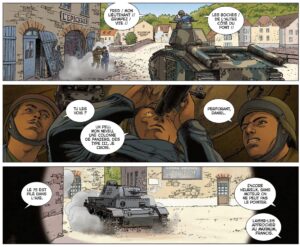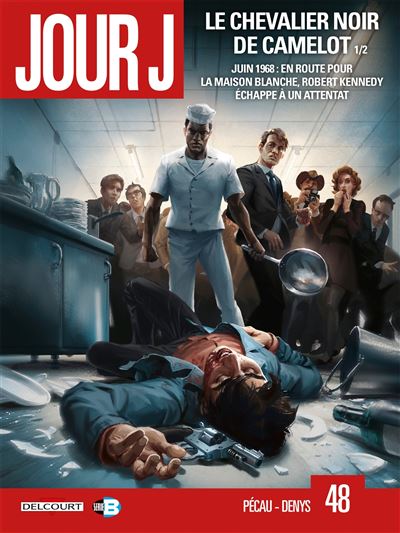The historical series of War Machines describes in comics the technological changes of tanks during several conflicts and in different armies. The Butcher of Stonne brings a novelty by presenting a French weapon the B1bis. Follow the instructions in our column.
One for all

Le Boucher de Stonne is a complete story in one volume but it is part of a collection: the series Machines de guerre chez Delcourt chooses to make an object the center of the subject, to make human a weapon, the tank in this case. The screenwriter Jean-Pierre Pécau, accustomed to historical series, knows how to propose an original approach. In 1944, during Operation Market Garden, a paratrooper in an English uniform – actually a German of Jewish religion – found himself in front of a German tank: a French B1bis. He knows it very well because he made it. This meeting is the beginning of a monologue where the soldier tells his comrades-in-arms how he ended up in the French army. This soldier is in the British army, in secret, because he has false papers. He fled persecution to come to France where he became a worker on tank engines. When war was declared, he insisted on enlisting.
After aviation in Indochina, Jean-Pierre Pécau details the evolution of tanks. The reader of Le Boucher de Stonne also discovers B1bis. As always in this collection, the book ends with a thick documentary file. In the dialogues, the tank's abilities are detailed but the novice reader understands everything, especially the qualities and flaws of the tank. Despite the brevity of the fighting of the France campaign, this French tank was the most feared. It passes everywhere but to the rhythm of a slug. Possessing thick armor, it is invulnerable to panzer guns. To show these specificities, the cartoonists Senad Mavric and Filip Andronik have a very realistic style, in the footsteps of historical comics, and are very precise on armament and uniforms.
All in the war

Le Boucher de Stonne is the story of a failure: that of French tactical blindness. The tank was designed in the 1940s and the soldiers who use it mostly list its flaws. It is very greedy in gasoline and slow to fill. These characteristics represent the tactical choices of the Maginot Line. The French army didn't see the tactical evolution – the importance of speed – but it just improved its weapons from World War I.
The tank is a pretext to describe the beginning of the war on the French side. The Battle of France was a stinging defeat and quickly folded, but it caused many casualties on both sides. The French army wanted to regain ground after the failure in the Ardennes. Unfortunately, the different units are completely uncoordinated. A column of tanks wanders in search of infantry. We also see the serious failures of the stewardship, which is unable to transport gasoline in quantity.
The spotlight is put on a tank crew and all its actions to defend the hill of Stonne. By this tank opposing both the infantrymen and raising the gauntlet of duels against powerful German tanks, Le Boucher de Stonne restores the coat of arms of the French army. These successes are so numerous that one can doubt their historical realism. Conversely, the opposing army is disembodied. There was, however, the possibility of showing both sides of the war by insisting on the second career of the French tank in the Wehrmacht. Comics sometimes become reactionary. In one page, we see a communist militant sabotaging the production line to avoid war under the orders of the party.
The first four volumes of War Machines validated the quality of the concept and this volume made in France proves it again. The screenplay of The Butcher of Stonne succeeds in turning a military failure into a success in comics and uses this object to describe the beginning of the war on the French side. To go even further, we could imagine that the series is interested in the news of conflicts by more recent tanks.
Find other titles from this collection such as The Star of Kursk and The Gray Wolf.







































